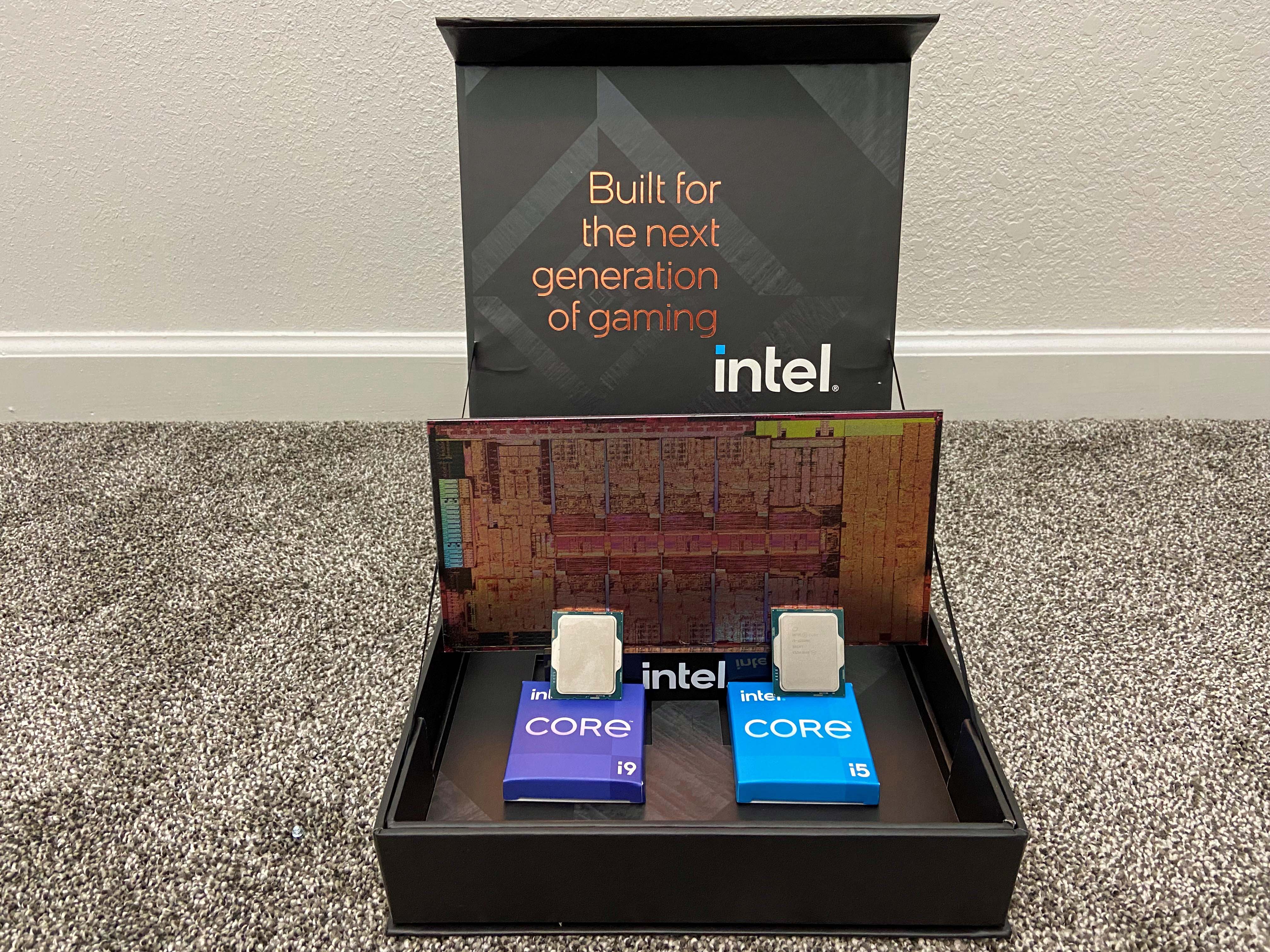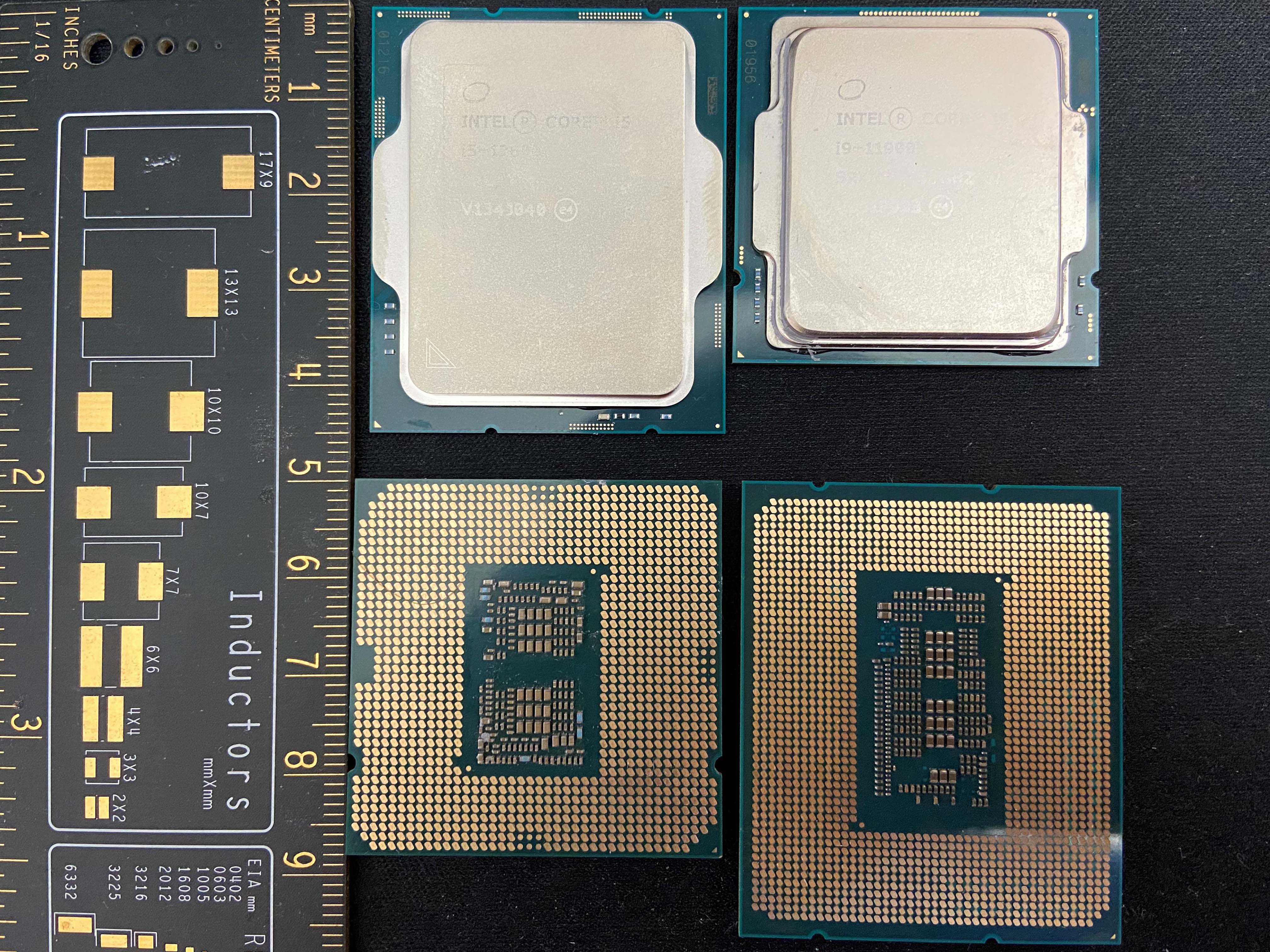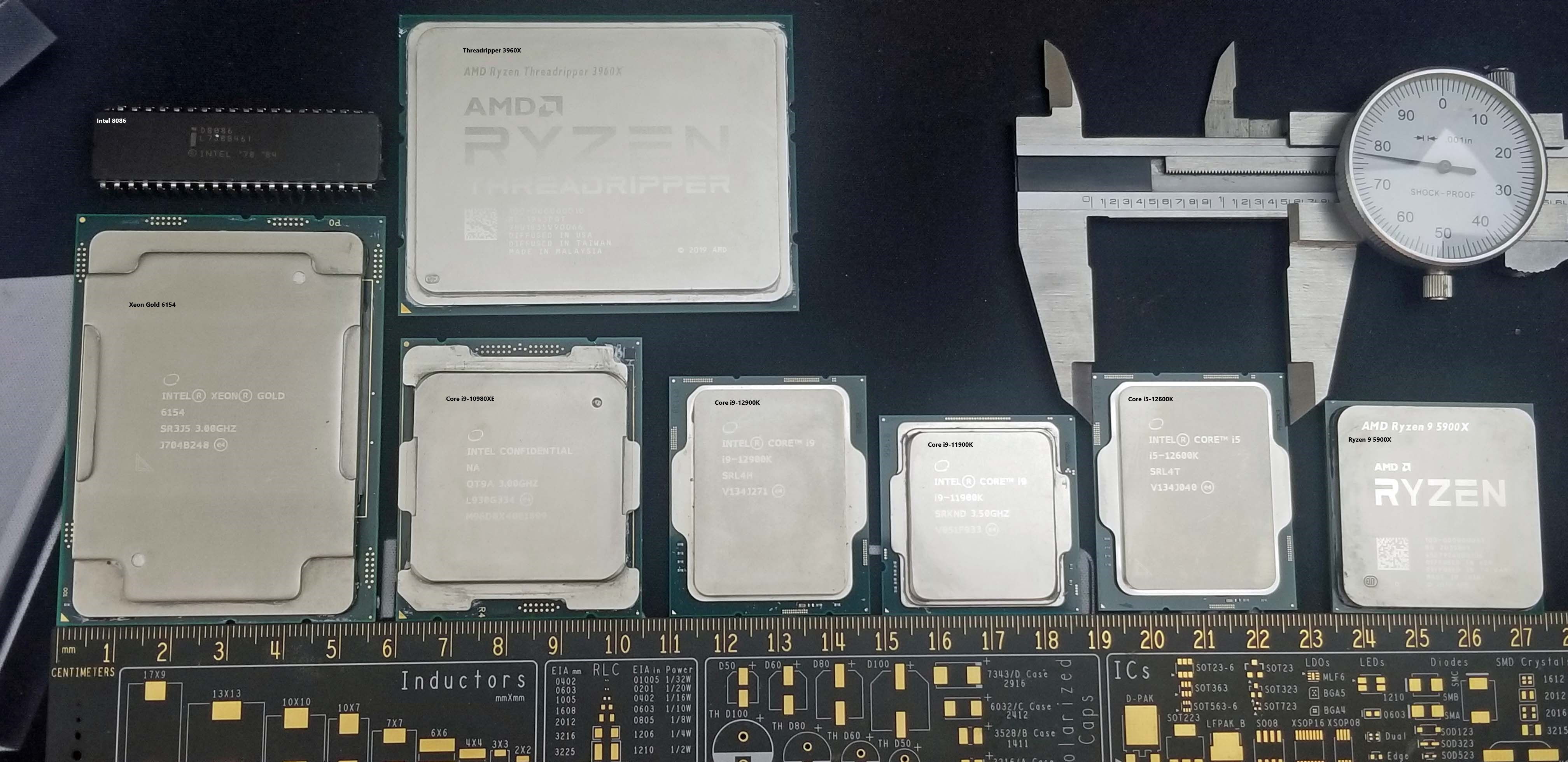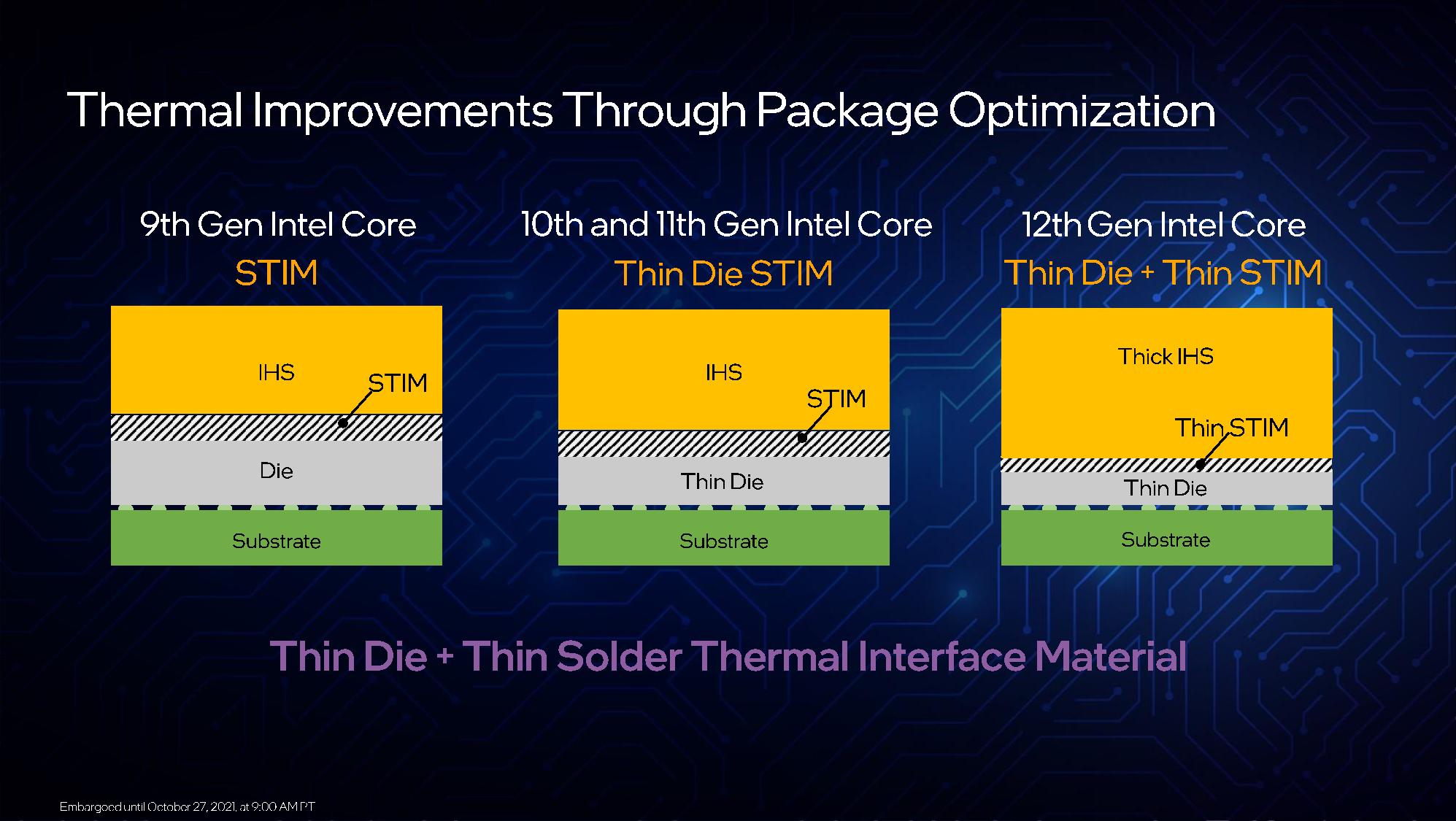Intel Shares Alder Lake Pricing, Specs and Gaming Performance: $589 for 16 Cores
Here we go...

Intel sent the Alder Lake chips in a special package that includes a cardboard insert with a printout of the Alder Lake microarchitecture, but we're most interested in the Core i9-12900K and Core i5-12600K that we'll put through their paces in our upcoming review.

Here we can see the top of the 12900K and the bottom of the 12600K next to the previous-gen 11900K and 10900K processors. The much larger array of contact pads on the rectangular Alder chips stands out — Alder Lake-S drops into the LGA1700 socket with 1700 pins, while the Rocket and Comet Lake chips drop into the LGA1200 socket with 1200 pins.

The Rocket and Comet Lake chips measure 37 x 37mm, but the larger rectangular Alder Lake chips measure 45 x 35mm. While this is a big increase in the physical size of the chip, it still pales in comparison to the 45 x 45mm Core I9-10980XE, not to mention the massive 56 x 71mm Xeon Gold 6154 or the 70 x 59mm Threadripper 3960X we used for comparison. (We also threw in the OG Intel 8086 from ~1976, which measures 13 x 51mm.)
We measured the thickness of both Alder and Rocket's PCBs, and they're both around the same ~1mm, though Alder Lake's PCB is slightly thinner.
Rocket Lake's total Z-Height (thickness) from the top of the integrated heat spreader (IHS) to the bottom of the PCB measured 5mm compared to the Alder's ~4.5mm, meaning that Alder Lake isn't quite as tall as its predecessor. This aligns with reports that the LGA1700 socket is 'shorter' than LGA12XX and 115X, with a total 8.91mm Z-height compared to 9.29mm.

Intel shared this image of the progression of its chip packages over the last few generations, with the company gradually thinning the die to improve thermal dissipation. That also helps improve overclockability by adding additional thermal headroom.
This time around, Intel reduced the PCB thickness by an additional 35% and thinned the STIM (Solder Thermal Interface Material) by 15%. Intel also used a larger, thicker copper IHS that serves as a thermal slug to absorb heat. You'll notice that Intel's image shows all four generations of chips with the same overall height, yet we've measured a ~.5mm Z-Height reduction for Alder Lake. We're following up with Intel to learn more.
You'll need a cooler conversion kit if you want to use existing LGA 115X coolers with the Alder Lake chips, and there are reports that some kits don't maintain an even pressure due to the difference in Z-Heights. We'll update you as we learn more, but be sure to do due diligence when you select your cooler.
You'll also notice that Rocket Lake's IHS now has a faint silkscreened triangular logo on the bottom left, which coincides with the typical yellow triangle printed on the PCB that you use to align the processor in the socket. Additionally, Alder Lake has a unique notch arrangement to help prevent installing the processor into the socket incorrectly, with two notches at both the top and bottom, as opposed to LGA 12XX and 115X that came with two notches (one on either side).
- MORE: Best CPUs for Gaming
- MORE: CPU Benchmark Hierarchy
- MORE: AMD vs Intel
- MORE: All CPUs Content
Get Tom's Hardware's best news and in-depth reviews, straight to your inbox.
Current page: The Alder Lake Unboxing
Prev Page Splashing Into Alder Lake Next Page Out With the TDP, in With the PBP
Paul Alcorn is the Editor-in-Chief for Tom's Hardware US. He also writes news and reviews on CPUs, storage, and enterprise hardware.
-
wifiburger 589$ is awesome, very interestingReply
If I do upgrade I'll go with DDR4 since I already have a good 4400 bdie kit -
-Fran- Reply
That's the 1K tray pricing, not "plebian" MSRP.wifiburger said:589$ is awesome, very interesting
If I do upgrade I'll go with DDR4 since I already have a good 4400 bdie kit
At retail it'll definitely be more than that. Still, finding it under $700 may be totally possible, so good news there for sure. I'd say it's like at least 20% increase over the prices mentioned.
Seems like Intel is not going ballistic with pricing, so that also hints at them being cautious. Not a bad thing, TBH.
Regards. -
VforV As an AMD user all I care about Alder Lake is the price and I do hope these are the real prices on launch, even if these are only the mythical MSRPs, they should make AMD drop their Zen3 prices too.Reply
So that's good news if true, for me.
Also I like how in their own gaming benchmarks intel has a average of about +15% lead over Zen3, like the same gap Zen3 V-Cache will add. Not the +50% all the synthetic benchmarks and click-bait titles were shouting from the rooftops up until now... -
TerryLaze Reply
Yes and all the big chains that will buy way more than just 1k will get them for cheaper than that.Yuka said:That's the 1K tray pricing, not "plebian" MSRP.
First couple of weeks are going to be higher prices because that always happens, the big question is what will happen after that, if scalpers will be a big issue or if they are going to be sold for more by retailers. -
Roland Of Gilead 'The Alder Lake chips are available for preorder today, but they won't ship until October 4, 2021' - Am I stuck in a time warp! :tearsofjoy: So I could have ordered this 3 weeks ago!?Reply -
-Fran- Reply
I was told Microcenter already has it listed for $650.TerryLaze said:Yes and all the big chains that will buy way more than just 1k will get them for cheaper than that.
First couple of weeks are going to be higher prices because that always happens, the big question is what will happen after that, if scalpers will be a big issue or if they are going to be sold for more by retailers.
Regards. -
TerryLaze Reply
Looking at price history the 11900k was available at exactly the MSRP from day one, not everywhere but still, there is no reason to believe that the 12900k will be different, except for retailers that might take advantage of the situation.Yuka said:I was told Microcenter already has it listed for $650.
Regards.
https://pcpartpicker.com/product/mDcG3C/intel-core-i9-11900k-35-ghz-8-core-processor-bx8070811900k?history_days=365 -
-Fran- Reply
Not disagreeing. I mentioned Microcenter as they're usually your "best case scenario" for retail pricing.TerryLaze said:Looking at price history the 11900k was available at exactly the MSRP from day one, not everywhere but still, there is no reason to believe that the 12900k will be different, except for retailers that might take advantage of the situation.
https://pcpartpicker.com/product/mDcG3C/intel-core-i9-11900k-35-ghz-8-core-processor-bx8070811900k?history_days=365
Regards. -
hotaru251 kind of weird they knowingly posted benchmarks vs a nerfed ryzen os.Reply
should of just omitted it and posted fair ones later.
but props to em for mentioning it. -
nervousstate Reply
Not to mention everything else will be a premium at launch. PCIe5 and DDR5 are not going to make motherboards more affordable and DDR5 is at least 2X the price of DDR4 and overclocking the memory to actually achieve a benefit is still very much unknown and different than DDR3/4 due to the change to the power delivery as well as everything else that is new. We are also going to see the extended L3 Cache launched very soon from amd which they suggested is going to have a 20% improvement along with 16 REAL cores for about the same price as the 5950X - It does look like they have improved Single threaded performance over AMD but youll never get the same performance with 8 Atom Cores. The i5 looks like a compelling offer though. 6C/12T + 4 Low-Power Cores is going to compete well against the 5600X and LP cores will be nice for running docker containers or network services without effecting gaming performance. Unless of course AMD drops the price a little...Yuka said:That's the 1K tray pricing, not "plebian" MSRP.
At retail it'll definitely be more than that. Still, finding it under $700 may be totally possible, so good news there for sure. I'd say it's like at least 20% increase over the prices mentioned.
Seems like Intel is not going ballistic with pricing, so that also hints at them being cautious. Not a bad thing, TBH.
Regards.